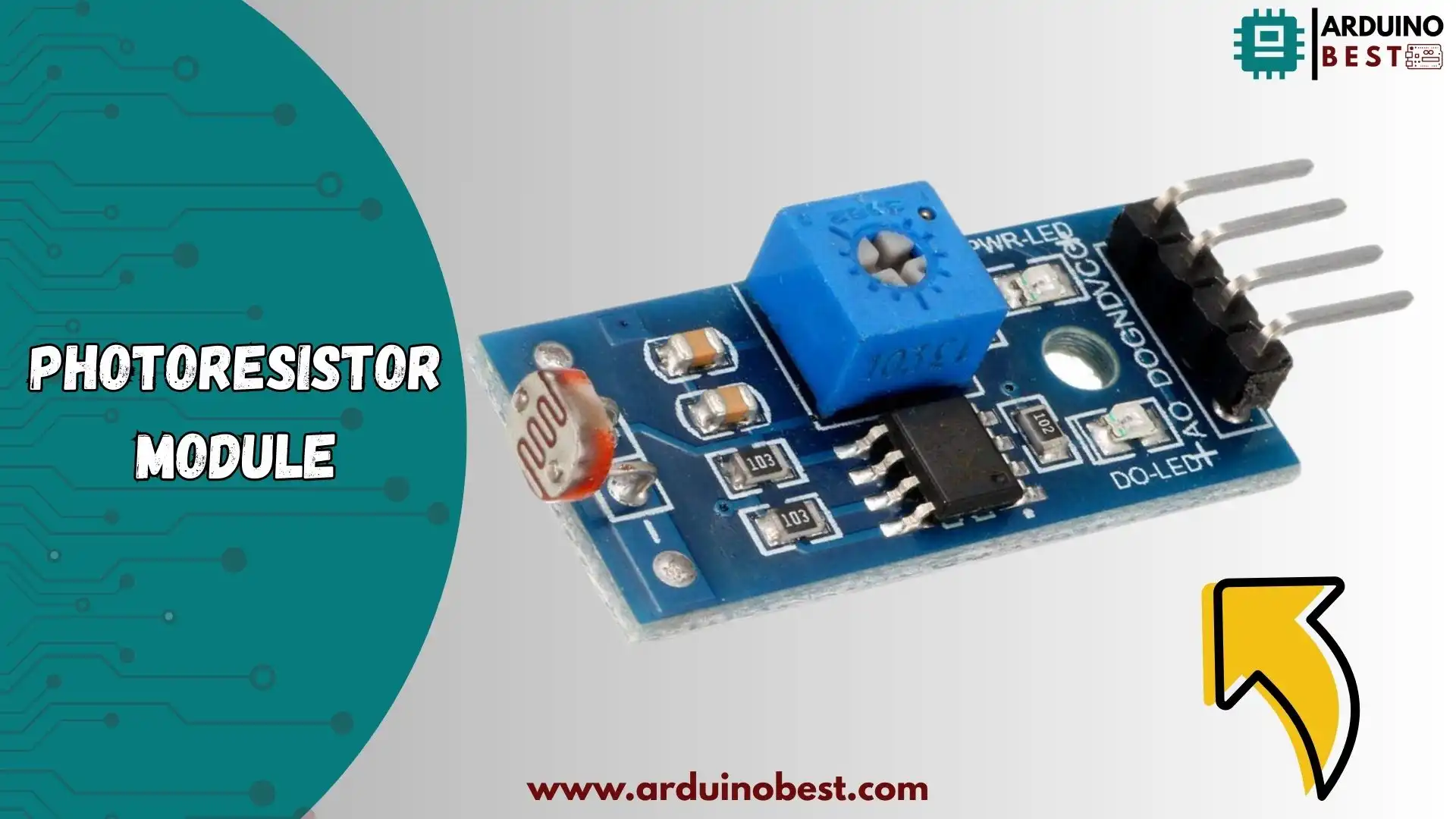Table of Contents
Introduction
Photoresistor modules are essential components in modern electronics, enabling devices to respond to varying light conditions. These modules play a key role in numerous applications, from automatic lighting systems to advanced solar tracking systems. Whether you’re working on a home automation project or designing an energy-efficient system, understanding how photoresistor modules function and their applications is crucial for effective implementation.
A photoresistor module typically consists of a photoresistor (also known as a Light Dependent Resistor, or LDR) and additional components such as amplifiers and voltage dividers to make integration with microcontrollers straightforward. These modules are commonly used in projects involving Arduino or Raspberry Pi.
To get started with photoresistor modules and their applications, it’s important to first understand the basic working principle of a photoresistor and how it detects light. Learn more about the working principle of photoresistors on Elprocus.
Understanding Photoresistors
What is a Photoresistor?
A photoresistor (also called an LDR) is a type of resistor whose resistance decreases when exposed to light. The more light that strikes the photoresistor, the lower the resistance, and vice versa. This unique property makes it an excellent tool for detecting changes in light levels.
These devices are widely used in applications that require light sensitivity, from automated lighting systems to optical sensors in security setups. Photoresistors are made from semiconductor materials like Cadmium Sulfide (CdS), Lead Sulfide (PbS), and Indium Antimonide (InSb), each sensitive to different parts of the light spectrum. Read more about the types of photoresistors here.
Working Principle
The working principle behind a photoresistor is based on photoconductivity. When light photons hit the semiconductor material of the LDR, they free up electrons, allowing the material to conduct electricity. This results in a decrease in resistance. Essentially, the device’s resistance is inversely proportional to the intensity of the light shining on it.
This mechanism allows photoresistor modules to act as light sensors in various electronic devices. For instance, the Arduino LDR sensor module can use a photoresistor to measure the intensity of ambient light in your environment.
Types of Photoresistors
- Cadmium Sulfide (CdS) Photoresistors: Sensitive to visible light and commonly used in consumer electronics and lighting applications.
- Lead Sulfide (PbS) Photoresistors: Designed to detect infrared light, making them useful in infrared applications like motion sensors.
- Indium Antimonide (InSb) Photoresistors: Best for detecting mid-infrared wavelengths, typically used in industrial sensors and military applications.
Photoresistor Modules: An Overview
What is a Photoresistor Module?
A photoresistor module is a more integrated component that combines a photoresistor with additional electronic circuits to facilitate easy interfacing with microcontrollers like Arduino or Raspberry Pi. These modules typically come with built-in voltage dividers, amplifiers, and sometimes comparators to help with analog-to-digital signal conversion, making them perfect for quick integration into a wide range of projects. Explore more about photoresistor modules here.
Components of a Photoresistor Module
- Photoresistor (LDR): Detects the intensity of light, the core component of the module.
- Comparator Circuit: Converts the analog signal from the LDR to a digital signal for easier processing by microcontrollers.
- Potentiometer: Allows users to adjust the sensitivity of the module by changing the threshold of light intensity.
- Indicator LEDs: Provide feedback on the module’s status, often used to show when a certain light threshold has been crossed.
Benefits of Using Photoresistor Modules
- Easy Integration: Simplifies the connection of light sensors to microcontrollers like Arduino, Raspberry Pi, or ESP32.
- Adjustable Sensitivity: The potentiometer allows for easy tuning of light sensitivity, making it adaptable to different lighting conditions.
- Low Power Consumption: Photoresistor modules typically consume very little power, making them ideal for battery-powered applications.
Applications of Photoresistor Modules
Automatic Lighting Systems
One of the most common applications of photoresistor modules is in automatic lighting systems. These systems use light sensors to detect the ambient light levels and adjust the lighting accordingly. For instance, photoresistor modules are used in streetlights to turn them on at dusk and off at dawn, improving energy efficiency and ensuring proper lighting during nighttime.
Brightness Detection in Displays
In displays, especially in smartphones or tablets, photoresistor modules help automatically adjust screen brightness according to the surrounding light levels, enhancing user experience and conserving battery life. When exposed to bright light, the module decreases the brightness for better readability and vice versa.
Solar Tracking Systems
Solar energy systems use photoresistor modules in solar tracking systems to adjust the position of solar panels. By detecting the direction and intensity of sunlight, the system can optimize the angle of the panels for maximum energy absorption throughout the day.
Light-sensitive Alarms
In security systems, photoresistor modules are used to detect changes in light levels, triggering an alarm when there’s an unexpected change. This makes them ideal for detecting intruders in low-light environments or areas that are supposed to remain dark.
Photography Light Meters
Photographers often use photoresistor modules in handheld light meters to assess the intensity of ambient light in order to adjust the exposure settings of their cameras, ensuring the proper amount of light for photographs.
Integrating Photoresistor Modules with Microcontrollers
Connecting to Arduino
- Wiring: Connect the VCC pin of the photoresistor module to the 5V pin on Arduino, GND to GND, and the analog output to one of the Arduino’s analog input pins.
- Programming: You can use the
analogRead()function to obtain light intensity values from the photoresistor module and control other systems accordingly.
Connecting to Raspberry Pi
Raspberry Pi does not have a built-in ADC (Analog-to-Digital Converter), so you’ll need to use an external ADC like the MCP3008 to interface the module with the Raspberry Pi. Once connected, you can use Python to read the analog signals and trigger actions based on light levels.
Using with ESP32
The ESP32 microcontroller has built-in ADCs, so connecting a photoresistor module is simple. The module’s analog output can be fed directly into one of the ADC pins on the ESP32, allowing you to collect data and process it in real-time.
Programming Considerations
When programming a photoresistor module with a microcontroller, it’s essential to handle light measurement efficiently. Be sure to account for the fact that light levels will vary throughout the day, and calibrate your module accordingly to avoid false readings.
Selecting the Right Photoresistor Module
Factors to Consider
- Light Sensitivity: Choose a module that suits the light levels you are working with.
- Power Consumption: For battery-powered applications, opt for a low-power photoresistor module.
- Output Type: Consider whether you need analog or digital output, depending on the complexity of your system.
Common Specifications
- Resistance Range: The resistance range can vary significantly between different modules. Check for specifications to ensure it matches your needs.
- Response Time: If real-time light detection is required, select a module with a fast response time.
Recommended Modules
Some commonly used photoresistor modules include:
- KY-018 LDR Module for Arduino
- TCS3200 Color Sensor Module for Raspberry Pi
- Photoresistor Sensor Module for Solar Applications
Troubleshooting and Maintenance
Common Issues
- Inaccurate Readings: Calibrate the module periodically to ensure accurate light measurements.
- Sensor Degradation: Over time, photoresistors may degrade, especially in harsh environments, so consider replacing them when performance drops.
Maintenance Tips
- Regularly clean the module to remove dust or debris that may block light.
- If you’re using the module in outdoor environments, protect it from excessive moisture or temperature extremes.
FAQs
- What is a photoresistor module used for?
- A photoresistor module is used to detect light levels and trigger actions based on ambient light, such as turning on lights or adjusting brightness.
- How do you connect a photoresistor module to an Arduino?
- Connect the module’s VCC to the Arduino’s 5V pin, GND to GND, and the analog output to one of the analog pins. Use the
analogRead()function to get data.
- Connect the module’s VCC to the Arduino’s 5V pin, GND to GND, and the analog output to one of the analog pins. Use the
- What is the difference between photoresistor modules and regular LDRs?
- A photoresistor module integrates a photoresistor with additional components like comparators and amplifiers for easy interfacing with microcontrollers.
- Can I use a photoresistor module in outdoor applications?
- Yes, photoresistor modules are commonly used in outdoor applications like solar tracking systems and streetlights.
- How accurate are photoresistor modules?
- The accuracy depends on the quality of the module and the environment. Calibration and proper maintenance can ensure better accuracy.
Conclusion
In conclusion, photoresistor modules are versatile components that play a crucial role in light-sensitive systems, offering a broad range of applications, from automatic lighting systems to solar tracking. These modules are key to developing energy-efficient and responsive solutions in fields like home automation, security, and renewable energy. By understanding the components of photoresistor modules, their working principles, and the best practices for integration with microcontrollers like Arduino and Raspberry Pi, you can ensure that your projects are both efficient and effective.
Choosing the right photoresistor module is critical for achieving the desired performance, as different modules offer varying levels of sensitivity and response time. Additionally, integrating the modules properly and calibrating them to suit your specific application is essential for accurate light detection and system responsiveness. With proper maintenance, these modules can continue to function effectively, providing reliable performance in long-term use.
Incorporating photoresistor modules into your designs opens the door to creating smarter, more intuitive systems that react to environmental changes, enhancing user experience while conserving energy and resources. Whether you’re building an automated lighting system, a solar panel tracker, or a light-sensitive alarm, understanding and utilizing photoresistor modules will undoubtedly improve the performance and efficiency of your project.
Arduino Projects:
1- Complete Guide for DHT11/DHT22 Humidity and Temperature Sensor With Arduino
2- DHT11 – Temperature and Humidity Sensor
3- DHT22 – Temperature and Humidity Sensor (more accurate than DHT11)
4- BMP180 – Barometric Pressure and Altitude Sensor
5- BMP280 – Barometric Pressure & Temperature Sensor
6- BME280 – Temperature, Humidity, and Pressure Sensor
7- Arduino Flex Sensor Controlled Robot Hand
8- Arduino ECG Heart Rate Monitor AD8232 Demo
9- Arduino NRF24L01 Wireless Joystick Robot Car
10- Arduino Force Sensor Anti-Theft Alarm System
11- Arduino NRF24L01 Transceiver Controlled Relay Light
12- Arduino Rotary Encoder Controlled LEDs: A Complete Guide

